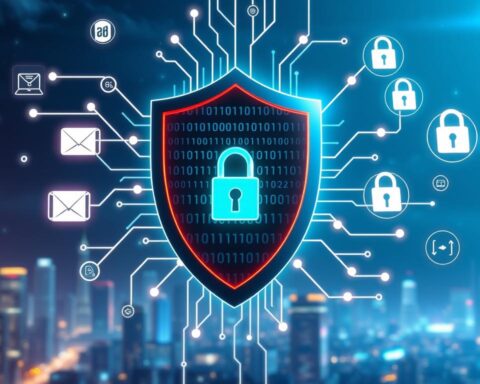Did you know that by 2025, over 20 billion Internet-connected devices will be in use globally1? This number shows how urgent it is to protect IoT devices. In our Day 20 Cybersecurity Training, we’ll look at how to keep IoT devices safe and reduce risks.
The term “Internet of Things” started in the 1990s. It described devices with computing power and Internet addresses2. By 2008, machines were already outnumbering people online2. This fast growth brings both chances and challenges, mainly in cybersecurity.
As more IoT devices are used, they do more tasks efficiently and at lower costs. But, the risks they pose grow too. It’s vital for us and companies to focus on IoT security1.
Using strong security steps like multifactor authentication and encryption is key. These methods protect data when it’s sent or stored1. By doing this, we can better defend against hackers and data breaches in the IoT world.
Key Takeaways
- IoT devices are projected to exceed 20 billion by 2025
- Unsecured IoT devices pose significant security risks
- Multifactor authentication enhances protection against unauthorized access
- Strong encryption is critical for keeping data safe
- Regular security updates and checks are vital
- Following IoT security laws is now required in some places
- Using risk assessment frameworks helps use security resources wisely
Understanding the IoT Security Landscape
The Internet of Things (IoT) has changed our world. It connects devices in new ways. This includes smart home security and industrial IoT security, making the landscape complex.
The Evolution of Connected Devices
Connected devices have evolved a lot. Today, we have smart gadgets that simplify our lives. By 2024, there will be 18.8 billion IoT devices worldwide, showing how fast this technology is growing3.
Current State of IoT Security Challenges
IoT devices face big security challenges. Over 70% of them lack security, making them easy targets for hackers4. For example, in 2017, hackers accessed a Las Vegas casino through a fish tank thermometer3.
| Security Challenge | Impact | Percentage |
|---|---|---|
| Weak Authentication | Unauthorized Access | 45% |
| Insecure Communication | Data Breaches | 60% |
| Lack of Updates | Vulnerability to Exploits | 70% |
Impact on Organizations and Individuals
IoT security issues affect many. Data breaches from IoT devices harm 29% of organizations worldwide, causing financial and reputation damage4. People’s personal data and privacy are also at risk from unsecured smart devices.
To fight these risks, we must focus on IoT device security. Using multi-factor authentication can cut unauthorized access by 80%. Also, doing thorough risk assessments can lower attack success by about 50%4.
Common IoT Device Vulnerabilities
The rapid growth of IoT devices has brought new challenges in iot vulnerability management. As these devices become more prevalent, understanding their weaknesses is key for effective iot threat prevention.
Default Credentials and Authentication Issues
Many IoT devices ship with weak default passwords, often using simple combinations like “admin” or “password.” This oversight leaves them vulnerable to unauthorized access and breaches5. Weak authentication is a primary attack vector, with credential theft being a preferred method for cybercriminals6.
Outdated Firmware and Software Risks
Timely software updates are critical for IoT security. Unfortunately, many vendors fail to release updates for older models, leaving devices exposed to known vulnerabilities5. Organizations often struggle with large deployments of IoT devices running different firmware versions, complicating the update process and expanding the attack surface6.
Network Security Weaknesses
Insecure networks are vulnerable to man-in-the-middle attacks, allowing cybercriminals to exploit protocol weaknesses and gain unauthorized access to sensitive data7. Many IoT devices transmit sensitive information in unencrypted formats, exposing them to network sniffing and interception6.
Physical Security Concerns
Physical security is often overlooked in IoT deployments. Reinforced designs and secure storage are essential for protecting devices against unauthorized access and tampering5. Failure to manage devices throughout their lifecycle can significantly increase vulnerability exposure, highlighting the importance of identifying and monitoring connected assets7.
Addressing these vulnerabilities requires a multi-layered approach to iot vulnerability management. This includes strong authentication, regular updates, encryption, and monitoring. By implementing these strategies, organizations can significantly enhance their iot threat prevention efforts and protect their IoT ecosystems from breaches.
Securing IoT Devices: Minimizing the Risks in a Connected World
In today’s world, the Internet of Things (IoT) is everywhere. Over 15 billion IoT devices are in use worldwide. This makes securing IoT devices more important than ever8.
The IoT is growing fast, bringing both chances and challenges. By 2030, we’ll have double the number of IoT devices. This growth means we need strong security strategies8.
One big issue is weak passwords on IoT devices. Many devices use easy-to-guess passwords. Using two-factor authentication (2FA) can protect these devices by 99.9%9.
Keeping firmware up-to-date is also key. But, about 70% of IoT devices are vulnerable because of outdated software. Regular updates can help, but many users don’t apply them9.
“The principle of least privilege access should be integrated along with continuous monitoring to enhance security in a connected environment.”
Securing IoT devices needs a variety of steps. Network segmentation can cut breach impact by 30%9. Also, using secure protocols like TLS is vital, as most IoT security issues come from unsecured connections9.
As IoT grows, so must our security efforts. With over 18 billion IoT devices worldwide, and more coming, security is critical10. By taking strong security steps, we can enjoy IoT benefits while keeping risks low.
Essential Security Measures for IoT Implementation
Securing IoT devices is key as their numbers grow. By 2025, we’ll have 25 billion IoT devices worldwide. This highlights the need for strong security measures11. Let’s look at important strategies for secure IoT implementation and improving IoT security.
Strong Password Policies and Authentication
Many IoT devices come with default passwords, posing a big security risk11. Users often don’t change these, making them easy targets on the dark web12. It’s important to have strong password policies. Use unique, complex passwords for each device and enable multi-factor authentication when possible.
Regular Updates and Patch Management
Many IoT devices lack updates, leaving them vulnerable11. Inconsistent patches can leave devices exposed for years12. Set up a regular update schedule. Use Remote Management and Monitoring (RMM) solutions to make patching easier.
Network Segmentation Strategies
IoT devices are always connected, expanding the attack surface12. Network segmentation is essential to reduce risks. Keep IoT devices on separate networks to limit damage. This is even more critical as more people work from home, connecting IoT devices to less secure networks11.
| Security Measure | Importance | Implementation Strategy |
|---|---|---|
| Strong Passwords | Critical | Unique, complex passwords for each device |
| Regular Updates | High | Scheduled patching using RMM solutions |
| Network Segmentation | Essential | Isolate IoT devices on separate network segments |
By using these essential security measures, organizations can improve their IoT security. A centralized management platform helps monitor devices in real-time. This is key for spotting anomalies and breaches12.
Secure IoT implementation is not just about protecting devices; it’s about safeguarding the entire ecosystem they operate within.
IoT Device Management Best Practices
Managing IoT devices well is key to keeping your network safe. With the IoT security market set to hit $73.6 billion by 2026, it’s vital to follow best practices13.
Device Lifecycle Management (DLM) is essential for keeping IoT devices secure. It covers everything from setting up devices to taking them offline14. Secure login methods and automated setup help prevent unauthorized access and errors14.
Keeping software up to date is also critical. About 80% of IoT security issues come from old software14. Using tools that learn from data can spot threats up to 90% better than old methods14.
Good device management can bring big benefits. Companies that manage their devices well see better performance and productivity. They might even save 20-30% on upgrades and resources14.
“Implementing multi-factor authentication and employing industry-standard encryption protocols are vital for safeguarding data transmitted and stored by IoT devices.”
Network segmentation is also important. It limits how far attackers can go in your network. Keeping IoT devices separate from others can greatly lower breach risks15. Regular security checks and audits are also key to finding and fixing problems and staying compliant15.
To boost iot security, consider these best practices:
- Implement the principle of least privilege
- Utilize secure communication protocols
- Deploy endpoint security solutions
- Conduct regular user education and training
By following these steps, companies can lower their risk of cyber attacks. This makes their IoT systems more secure and efficient.
| IoT Security Challenge | Impact | Solution |
|---|---|---|
| Outdated Software | 80% of vulnerabilities | Regular firmware updates |
| Unauthorized Access | 75% of security breaches | Multi-factor authentication |
| Data Exposure | $5 million average breach cost | Encryption protocols |
| Human Error | 64% of IoT security incidents | User education and training |
Network Security Protocols for IoT Environments
The Internet of Things (IoT) has changed our world, connecting billions of devices. This has opened up new opportunities. But, it also brings big security challenges. With over 30 billion IoT devices expected by 2025, the risk of cyber attacks has grown a lot16.
Encryption Standards and Implementation
Encryption is key to keeping data safe in IoT settings. Many devices use AES and SHA to protect data17. But, making sure all devices are well-protected is hard because they often have limited power18.
Access Control Mechanisms
Strong authentication is essential for keeping IoT devices safe. Using Multi-Factor Authentication (MFA) can greatly lower the risk of unauthorized access16. Role-based access control (RBAC) is also recommended, but many struggle to set it up for IoT devices16.
Traffic Monitoring Solutions
Monitoring is vital for stopping IoT threats. Systems like Security Information and Event Management (SIEM) can spot threats, but they’re not used enough in IoT16. It’s important to check for vulnerabilities regularly to find and fix weaknesses before they’re used by hackers17.

| Security Measure | Importance | Implementation Challenge |
|---|---|---|
| Encryption | Critical for data protection | Limited device resources |
| Multi-Factor Authentication | Reduces unauthorized access | User adoption |
| Traffic Monitoring | Essential for threat detection | Underutilization of tools |
As IoT grows, it’s more important than ever to use these security measures. Companies must focus on keeping IoT devices and data safe. This is key to protecting their assets in our connected world.
Risk Assessment and Mitigation Strategies
The Internet of Things (IoT) is growing fast, and so are the risks. The global IoT security market is expected to hit $73 billion by 2024. It will grow at a rate of 26.8% from 201919. This shows how important it is to have strong iot vulnerability management and iot risk mitigation strategies.
Vulnerability Assessment Procedures
Regular checks for vulnerabilities are essential in IoT networks. Companies that check their security often are 50% more likely to stop big breaches involving IoT devices19. These checks should include both automated scans and manual testing to find many vulnerabilities.
Threat Detection and Response
Fast threat detection is key in IoT settings. It takes about 280 days for organizations to spot and stop a breach involving IoT devices19. Using continuous monitoring and anomaly detection can make response times much faster20. This is important because IoT devices can be hacked in under 60 seconds19.
Incident Management Planning
A good incident management plan is vital for iot risk mitigation. Companies that use multi-factor authentication can cut unauthorized access risks by 99.9%19. Network segmentation is also powerful, reducing the risk of lateral movement during a breach by up to 90%19.
With 57% of businesses facing data breaches due to unsecured IoT devices, and 98% of IoT devices lacking proper security, the need for thorough iot vulnerability management is obvious19. By using these strategies, organizations can protect their connected devices and data in our complex digital world.
Advanced IoT Security Technologies
The IoT world is growing fast, with 30 billion connected devices expected by 203021. But, this growth also brings big security challenges. About 70% of IoT devices don’t have basic security21. New technologies are coming to make IoT security better and safer.
Artificial Intelligence (AI) and Machine Learning (ML) are leading in cybersecurity. They’re great at spotting patterns and oddities in big data. This makes them perfect for catching threats in IoT networks quickly.
Blockchain is also a big help for IoT security. It’s all about keeping data safe with its unique, unchangeable records. This way, devices and data can be trusted, keeping everything secure.
Hardware-based security is becoming more popular too. Things like Trusted Platform Modules (TPMs) and secure enclaves create a safe base for devices. They help protect against unauthorized access and data theft.
But, there are hurdles to overcome. IoT systems are diverse, and many devices don’t have much power. This makes it hard to add advanced security22. Yet, the benefits are worth it, like cutting security incidents by up to 45%21.
The IoT security market is set to hit $73 billion by 2027. Working together will be key to using these new technologies21. By using these innovations, companies can boost their security and move forward in the IoT world.
Conclusion
Securing IoT devices is key in our connected world. With billions of devices online, the risk of security breaches is high. For example, a Las Vegas casino’s fish tank thermometer was hacked, showing the dangers23.
The IoT security scene is complex. Threats like the Mirai botnet (2016) and BlueBorne (2017) have hit many devices. To keep IoT safe, using strong passwords, updating regularly, and encrypting data are musts24.
Companies need a full plan for IoT security. This includes dividing networks, watching them closely, and teaching users about risks. Using the Zero Trust model and real-time protection helps fight cyber threats2324.
Looking ahead, making IoT security a top priority is essential. By using top-notch cybersecurity and staying updated, we can enjoy IoT’s benefits while managing its risks23.
FAQ
What is IoT and why is securing IoT devices important?
What are some common vulnerabilities in IoT devices?
How can I secure my smart home devices?
What is network segmentation, and why is it important for IoT security?
How often should I update my IoT devices?
What role does encryption play in IoT security?
How can organizations assess and mitigate IoT security risks?
What are some emerging technologies in IoT security?
How does industrial IoT security differ from consumer IoT security?
What steps can I take to ensure the secure implementation of IoT devices in my organization?
Source Links
- Careful Connections: Keeping the Internet of Things Secure – https://www.ftc.gov/business-guidance/resources/careful-connections-keeping-internet-things-secure
- Risk and the Internet of Things – https://www.ntia.gov/files/ntia/publications/csis_managingriskinternetofthings.pdf
- IoT Security: Protecting the Connected World – https://asimily.com/blog/iot-security-navigating-the-connected-world/
- How and why to secure IoT devices | Recent News | Beringer Technology Group – https://www.beringer.net/beringerblog/how-and-why-to-secure-iot-devices/
- Security Issues of IoT: Securing Your IoT Device in 2024 – Device Authority – https://deviceauthority.com/security-issues-of-iot-securing-your-iot-device-in-2024/
- Top 10 IoT Security Risks and How to Mitigate Them – https://www.sentinelone.com/cybersecurity-101/data-and-ai/iot-security-risks/
- Top IoT Device Vulnerabilities: How To Secure IoT Devices | Fortinet – https://www.fortinet.com/resources/cyberglossary/iot-device-vulnerabilities
- IoT Device Monitoring: Safeguarding Your Connected World – https://www.portnox.com/blog/iot-security/iot-device-monitoring-safeguarding-your-connected-world/
- Securing Internet of Things (IoT) Devices: Protecting the Connected World – https://www.linkedin.com/pulse/securing-internet-things-iot-devices-protecting-world-coloço-mixtro
- Securing a Connected World: Why IoT and OT Demand a Zero Trust Approach | GDIT – https://www.gdit.com/perspectives/latest/securing-a-connected-world-why-iot-and-ot-demand-a-zero-trust-approach/
- Top IoT Security Challenges and Best Practices – https://www.balbix.com/insights/addressing-iot-security-challenges/
- How To Secure IoT Devices | NinjaOne – https://www.ninjaone.com/blog/how-to-secure-iot-devices/
- Securing IoT Devices And Networks – https://atlantisuniversity.edu/au_blog/securing-iot-devices-and-networks/
- Securing IoT Device Lifecycle Management: Best Practices for Each Stage – Device Authority – https://deviceauthority.com/securing-iot-device-lifecycle-management-best-practices-for-each-stage
- 8 Best Practices for Securing IoT Devices – https://bcs365.com/insights/8-best-practices-for-securing-iot-devices
- Securing the Internet of Things – https://www.linkedin.com/pulse/securing-internet-things-ryan-shah-l0bse
- Securing IoT Networks: Best Practices for Ensuring Data Protection | dig8ital – https://dig8ital.com/post/iot-network-security/
- Network Security for IoT: Safeguarding the Connected World – https://medium.com/@teja.ravi474/network-security-for-iot-safeguarding-the-connected-world-87fd6aefc672
- Risk Mitigation Strategies with Comprehensive IoT Security Solutions | Microminder Cybersecurity | Holistic Cybersecurity Services – https://www.micromindercs.com/blog/comprehensive-iot-security-solutions
- Strategies for Securing Internet of Things (IoT) Devices – Brandefense – https://brandefense.io/blog/drps/strategies-for-securing-internet-of-things-iot-devices/
- Safeguarding IoT Systems in a Connected World – https://intelliwings.com/blogposts/2024/10/11/safeguarding-iot-systems-in-a-connected-world/
- The Importance of IoT Security Solutions: Protecting the Connected World – https://www.linkedin.com/pulse/importance-iot-security-solutions-protecting-rkhnf
- The Role of Cybersecurity for IoT Devices – Veridify Security – https://www.veridify.com/the-role-of-cybersecurity-for-iot-devices/
- Internet of Things (IoT) Security: Safeguarding the Connected World – https://www.linkedin.com/pulse/internet-things-iot-security-safeguarding-connected-world









